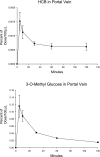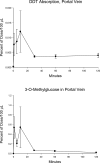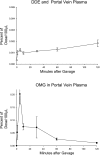Lymphatic and portal vein absorption of organochlorine compounds in rats
- PMID: 19056760
- PMCID: PMC2643918
- DOI: 10.1152/ajpgi.90517.2008
Lymphatic and portal vein absorption of organochlorine compounds in rats
Abstract
The route of absorption of ingested compounds is a determinant of their distribution and metabolism. Portal vein absorption results in direct transport to the liver, where metabolism may take place before extrahepatic delivery. Lymphatic absorption can result in delivery of parent compound to nonhepatic tissues. Understanding the fate of an ingested compound requires determination of the importance of each of these routes. Portal vein absorption can be estimated from the difference in concentrations of an ingested compound between the portal vein and peripheral vessel blood. To make these estimations, one must make assumptions on the basis of estimates of flow rate and dilution. We report here methodology that allows a direct measurement of portal vein absorption that is independent of these assumptions. Mesenteric lymph was diverted from rats by cannulation. Portal blood was sampled after duodenal infusion of a bolus of compound of interest along with a portal absorption marker, 3-O-methylglucose. Since lymph was diverted, the appearance in portal blood was solely the result of portal absorption. Absorption was quantified by the areas under the curve for the compound and marker. Portal absorption was a function of the octanol/water partition coefficients for four organochlorine compounds: hexachlorobenzene, pentachlorophenol, DDT, and its metabolite 1,1,1-trichloro-2,2-bischlorophenylethylene.
Figures










References
-
- Centers for Disease Control and Prevention. Third National Report on Human Exposure to Environmental Chemicals. Atlanta, GA: Department of Health and Human Services, 2005.
-
- Charman WNA, Stella VJ. Effects of lipid class and vehicle on the intestinal lymphatic transport of DDT. Int J Pharm 33: 165–172, 1986.
-
- D'Almeida MS, Cailmail S, Lebrec D. Validation of transit-time ultrasound flow probes to directly measure portal blood flow in conscious rats. Am J Physiol Heart Circ Physiol 271: H2701–H2709, 1996. - PubMed
-
- Gomez-Catalan J, To-Figueras J, Rodamilans M, Corbella J. Transport of organochlorine residues in the rat and human blood. Arch Environ Contam Toxicol 20: 61–66, 1991. - PubMed
-
- Hoffman DJ, Seifert T, Borre A, Nellans HN. Method to estimate the rate and extent of intestinal absorption in conscious rats using an absorption probe and portal blood sampling. Pharm Res 12: 889–894, 1995. - PubMed
Publication types
MeSH terms
Substances
Grants and funding
LinkOut - more resources
Full Text Sources
Miscellaneous

